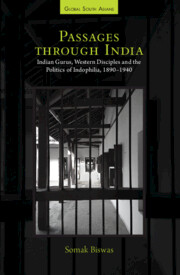4 - Practices of Discipleship: Vivekananda and His Women Disciples, 1890–1910
Published online by Cambridge University Press: 30 June 2023
Summary
Introduction
Unlike Gandhi or Tagore, Vivekananda (1863–1902) did not have female Indian disciples. Vivekananda's female disciples were British, American or European. They did not live monastic ashram lives, and their experiences of discipleship diverge significantly because of that spatial difference. While a product of late nineteenth-century cultural nationalism, Vivekananda himself predated the decades of 1910s and1920s, a period that saw the intensification of Indian political nationalism and defined the activities of Gandhi and Tagore's Western disciples.
Ramakrishna, the nineteenth-century Bengali mystic, was famous for his aversion to women and gold (kaminikanchan) – unless they were amply maternal or daughterly, both forms that negated or transcended their sexuality. The initiation into conventional monasticism meant a withdrawal from the world; overcoming attachments to women was key to that process. His disciples inherited and practised such an approach rigorously. Male disciples’ access to Sarada Devi's household (Ramakrishna's wife, regarded as the Holy Mother by disciples) was tightly bound by purdah rules. The Ramakrishna Math and Mission, established by Vivekananda with his community of brother-monks, made important departures from conventional monasticism through an active role in social service, or seva. However, the mission did not allow for the equal co-presence of women monks.
Vivekananda intended to institute schools for Hindu women's education. The immediate lack of female takers within India accorded Western women (and workers in general) a special place in his projects. In this, he followed the precedent set by the Brahmo Samaj and other reformist societies in Bengal, Madras and Bombay, that freely enlisted the intervention of white women inspired by a zeal to educate their Indian ‘sisters’. His wish to have ‘heaps of other English workers out here’ for different initiatives such as a farm colony in Bihar remained unfulfilled. Those who followed him to India and sustained an interest even after his death became important figures in the larger history of Western Indophilia, helping produce forms of India and Hinduism for both universalist and nationalist consumption.
Following on from the earlier examination of letters and ashrams, this chapter continues to explore and expand on the theme of self-making across a range of intimate sites.
- Type
- Chapter
- Information
- Passages through IndiaIndian Gurus, Western Disciples and the Politics of Indophilia, 1890–1940, pp. 155 - 202Publisher: Cambridge University PressPrint publication year: 2023



